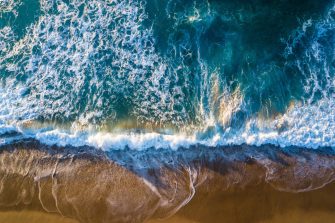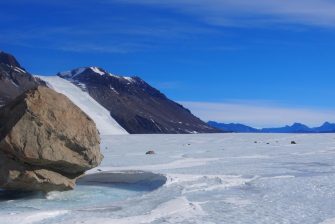
The PRECISE Network: Dedicated to improving regional projections of potential extreme future sea-level rise.
Summary
The potential of regional extreme sea-level rise remains a key socioeconomic uncertainty for millions across the Asia-Pacific region due to the likely impacts on coastal erosion, inundation and for water resource management. Led by UNSW researchers, the PRECISE Network forms a multidisciplinary Asia Pacific wide network, designed to share, strengthen, and build our capacity in key research areas fundamental to reducing this uncertainty, and ensure effective communication with key stakeholders including government, industry and the public.
-
Over the past century, global mean sea level (GMSL) has risen by about 16 cm (i.e. an average rate of 1.6 mm/year). Recently this rate has increased to around 3 mm/year, an effective doubling largely due to thermal expansion and the melting of glaciers worldwide. The latest IPCC (AR5) report indicated that in the absence of significant mitigation of greenhouse-gas emissions, sea level is expected to rise by approximately 0.2-0.8 m over the 21st century.
There is, however, considerable uncertainty in these global projections; recent research has suggested that these may be significant underestimates due to non-linear response of the Earth’s ice sheets to climate forcing. Additionally, regional sea-level rise is highly variable due to the combination of climate, the vertical movement of land, variations in the Earth’s gravitational field (due to varying water distribution across the oceans), the storage of water on land (due to damming and hydrological changes) and changes in ocean circulation. Therefore, despite marked advances in our understanding of the physical processes driving contemporary sea-level rise, the potential for extreme regional sea-level rise under future climate projections remains a subject of critical uncertainty. This is particularly acute across the Asia-Pacific region, with millions of people living within meters of current sea level and with key infrastructure situated in and around low-lying coastal regions.
Coastal erosion and inundation in action during a storm surge event at the site of a new domestic build in the Illawarra region of New South Wales, Australia in 2016To address this global challenge, the PRECISE Network (Projecting potential Regional Extremes in sea level rise due to Climate, IsostaSy and ocean thermal Expansion) aims to build research cooperation and capacity in key areas of uncertainty in sea level projection. Led by Dr Chris Fogwill (ESSRC research group) and a multidisciplinary team of leading geoscientists from world-class institutions across the Asia-Pacific – including UNSW, ANU, University of Sydney, Victoria University of Wellington, University of Tokyo and the University of Wollongong – the PRECISE Network is ideally placed to transform research into this crucial topic across the Asia Pacific region.
By focusing on capacity building and networking with key stakeholders, the PRECISE Network will ensure an enduring legacy that will drive scientific advances and reduce uncertainty in regional sea-level rise projections. This will build Australia’s capacity to respond to environmental change and provide crucial information to key stakeholders across the Asia-Pacific region to inform risk-reduction strategies.
-
UNSW
Dr Chris Fogwill (ESSRC / CCRC)
Prof. Chris Turney (ESSRC / CCRC)
Prof. John Church (CCRC)
Prof. Matt England (CCRC)
Dr Martin Andersen (CWI)Australian National University
Dr Anthony Purcell
Prof. Eelco Rohling
Dr Fiona Hibbert
Dr Kathrine GrantUniversity of Sydney
University of Tasmania / Institute of Marine and Antarctic Studies
Prof. Matt King
Dr Chris Watson
Prof. Nathaniel BindoffUniversity of Wollongong
Dr Amy Dougherty
University of Tokyo, Japan
Prof. Yusuke Yokoyama
Prof. Ayako Abe-OuchiVictoria University of Wellington, New Zealand
-
1. Church, J. A. et al. Sea Level Change. in Climate Change 2013: The Physical Science Basis. Contribution of Working Group I to the Fifth Assessment Report of the Intergovernmental Panel on Climate Change (eds T.F. Stocker et al.) Ch. 13, 1137–1216 (Cambridge University Press, 2013).
2. Fogwill, C.J., Turney, C.S.M., Golledge, N.R., Etheridge, D., Rubino, M., Thornton, D.P., Baker, A. Woodward, J., Winter, K., van Ommen, T. Moy, A., Curran, M. Davies, S.M., Weber, M., Bird, M.I., Munksgaard, N., Menviel, L., Rootes, C.M., Ellis, B., Millman. H. Vohra, J. Rivera, A., Cooper, A. (2017). Antarctic ice sheet discharge driven by atmosphere ocean feedbacks at the Last Glacial Termination. Scientific Reports. 7. Article No 39979.
3. Fogwill C. J., C. S. M. Turney, M. H. England, et al., 2014: Testing the sensitivity of the East Antarctic Ice Sheet to Southern Ocean dynamics: Past changes and future implications, Journal of Quaternary Science, 29, 91-98.
4. Golledge N. R.,Fogwill C.J. et al. The multi-millennial Antarctic commitment to future sea-level rise. Nature 526, 421-425, 2015.
5. England, M. H., et al., 2014: Recent intensification of wind-driven circulation in the Pacific and the ongoing warming hiatus, Nature Climate Change, 4, 222-227.
6. Turney, C.S.M., Fogwill, C.J., et al., (2015) Tropical and mid-latitude forcing of continental Antarctic temperatures. The Cryosphere, 9, 2405-2415.
7. PALAEOSENS Project Members (Rohling, E.J., Sluijs, A., Dijkstra, H.A., Köhler, P., van de Wal, R.S.W., von der Heydt, A.S., Beerling, D., Berger, A., Bijl, P.K., Crucifix, M., deConto, R., Drijfhout, S.S., Fedorov, A., Foster, G., Ganopolski, A., Hansen, J., Hönisch, B., Hooghiemstra, H., Huber, M., Huybers, P., Knutti, R., Lea, D.W., Lourens, L.J., Lunt, D., Masson-Demotte, V., Medina-Elizalde, M., Otto-Bliesner, B., Pagani, M., Pälike, H., Renssen, H., Royer, D.L., Siddall, M.,Valdes, P., Zachos, J.C., and Zeebe, R.E), Making sense of palaeoclimate sensitivity. Nature, 491, 683–691, 2012.
8. Grant, K.M., Rohling, E.J., Bar-Matthews, M., Ayalon, A., Medina-Elizalde, M., Bronk Ramsey, C., Satow, C., and Roberts, A.P., Rapid coupling between ice volume and polar temperature over the past 150 kyr. Nature, 491, 744–747, 2012.
9. Hansen, J., Kharecha, P., Sato, M., Masson-Delmotte, V., Ackerman, F., Beerling, D., Hearty, P.J., Hoegh-Guldberg, O., Hsu, S.-L., Parmesan, C., Rockstrom, J., Rohling, E.J., Sachs, J., Smith, P., Steffen, K., Van Susteren, L., von Schuckmann, K., and Zachos, J.C., Assessing "dangerous climate change": required reduction of carbon emissions to protect young people, future generations and nature. PLoS ONE, 8, e81648, doi:10.1371/journal.pone.0081648, 2013.
10. Martínez-Botí, M.A., Foster, G.L., Chalk, T.B., Rohling, E.J., Sexton, P.F., Lunt, D.J., Pancost, R.D., Badger, M.P.S., and Schmidt, D.N., Plio-Pleistocene climate sensitivity evaluated using high-resolution CO2 records. Nature, 518, 49–53, 2015.
11. Hibbert, F.D., Rohling, E.J., Dutton, A., Williams, F.H., Cutcharavan, P.H., Zhao, C., and Tamisiea, M.A., Corals as indicators of past sea-level change: a global repository of U-series dated benchmarks. Quaternary Science Reviews, 145, 1–56, 2016.
12. Abraham JP, Baringer M, Bindoff NL, Boyer T, Cheng LJ, et al., 'A review of global ocean temperature observations: Implications for ocean heat content estimates and climate change', Reviews of Geophysics, 51, (3) pp. 450-483. ISSN 8755-1209 (2013)
13. Hegerl GC, Karl TR, Allen M, Bindoff NL, Gillett N, et al., 'Climate Change Detection and Attribution: Beyond Mean Temperature Signals', Journal of Climate, 19, (20) pp. 5058-5077. ISSN 0894-8755 (2006)
14. King MA, Bingham RJ, Moore P, Whitehouse PL, Bentley MJ, et al., 'Lower satellite-gravimetry estimates of Antarctic sea-level contribution', Nature, 491, (7425) pp. 586-590. ISSN 0028-0836 (2012)
15. King MA, Keshin M, Whitehouse PL, Thomas ID, Milne G, et al., 'Regional biases in absolute sea-level estimates from tide gauge data due to residual unmodeled vertical land movement', Geophysical Research Letters, 39, (14) Article L14604. ISSN 0094-8276 (2012)
16. Watson CS, White NJ, Church JA, King MA, Burgette RJ, et al., 'Unabated global mean sea-level rise over the satellite altimeter era', Nature Climate Change, 5, (6) pp. 565-568. ISSN 1758-678X (2015)
17. Dutton, A, Webster, J. M., Zwartz, D., Lambeck, K., and Wohlfarth, B., (2015), Tropical tales of polar ice: evidence of Last Interglacial polar ice sheet retreat recorded by fossil reefs of the granitic Seychelles islands: Quaternary Science Reviews, 107, 182-196.
18. Woodroffe, C. D., and Webster, J. M., Coral Reefs and Sea-Level Change. (2014). Marine Geology, 352, 248-267.
19. Webster J. M., Clague, D. A., Coleman-Riker K., Gallup C., Braga J. C., Potts D., Moore. G. J., Winterer, E. L., Paull. C. K, (2004). Drowning of the -150 m reef off Hawaii: A casualty of global meltwater pulse 1A?, Geology, 32, 249-252. DOI: 10.1130/G20170
20. Saito F, Abe-Ouchi A, Takahashi K, Blatter H (2016) SeaRISE experiments revisited: potential sources of spread in multi-model projections of the Greenland ice sheet. The Cryosphere 10:43- 63, doi:10.5194/tc-10-43-2016
21. Deschamps, P., Durand, N., Bard, E., Hamelin, B., Camoin, G., Thomas, A. L., Henderson, G. M., Okuno, J. and Yokoyama, Y. Ice-sheet collapse and sea-level rise at the Bolling warming 14,600 years ago, Nature, 483, 559-564, 2012.
22. Yokoyama, Y., Anderson, J.B., Yamane, M., Simkins, L.M., Miyairi, Y., Yamazaki, T.,
Koizumi, M., Suga, H., Kusahara, K., Prothro, L., Hasumi, H., Southon, J.R., and Ohkouchi, N. Widespread collapse of the Ross Ice Shelf during the late Holocene. Proceedings of the National Academy of Sciences of the USA, 113 (9) 2354-2359, 2016.
23. Yokoyama, Y., K. Lambeck, P. De Deckker, P. Johnston and L. K. Fifield, Timing of the
Last Glacial Maximum from observed sea-level minima, Nature, 406, 713-716, 2000.
24. Abe-Ouchi, A., F. Saito, K. Kawamura, M. Raymo, J. Okuno, K. Takahashi and H. Blatter (2013): Insolation driven 100,000-year glacial cycles and hysteresis of ice sheet volume. Nature, 500, 190–193
25. Jones, R.S., Mackintosh, A.N., Norton, K.P., Golledge, N.R., Fogwill, C.J., Kubik, P.W., Christl, M. & Greenwood, S.L. 2015. Rapid Holocene thinning of an East Antarctic outlet glacier driven by marine ice sheet instability. Nature Communications 6:8910 DOI: 10.1038/ ncomms9910 (2015).
26. Mackintosh, A., Golledge, N., Domack, E., Dunbar, R., Leventer, A., White, D., Pollard, D., DeConto, R., Fink, D., Zwartz, D., Gore, D., and Lavoie, C. 2011. Retreat of the East Antarctic Ice Sheet during the last glacial termination. Nature Geoscience. 4, 95-202.
27. Dougherty, A.J., Choi, J-H., and Dosseto, A., 2016, Prograded Barriers + GPR + OSL = Insight on coastal change over intermediate spatial and temporal scales. Journal of Coastal Research, SI 75, v. 2, p.368-372
28. Wainright, David R, Ranasinghe, Rosh, Callaghan, David P., Woodroffe, Colin D., Jongejan Ruben, Dougherty, Amy J., Rogers, Kerrylee, and Cowell, Peter J., 2015, Moving from Deterministic towards Probabilistic Coastal Hazard and Risk Assessment: Development of a Modelling Framework and application to Narrabeen Beach, New South Wales, Australia. Coastal Engineering. v.96, p.92-99
29. Dougherty, Amy J., 2014, Extracting a record of Quaternary storm events and sea-level change from prograded coastal stratigraphy using ground penetrating radar. Continental Shelf Research. v.86, p.116-131
30. Woodroffe, C., Callaghan, D., Cowell, P., Wainwright, D., Rogers, K. Ranasinghe, R. and Dougherty, Amy J., 2014. A framework for modelling the risks of climate-change impacts on Australian coasts. Applied Studies in Climate Adaptation, Plautikof, Jean, P., Boulter, Sarah L., Barnett, J., and Rissik, D. (Ed.), p.181-189.











